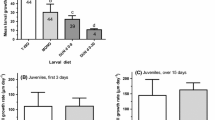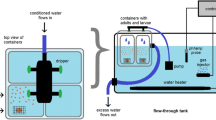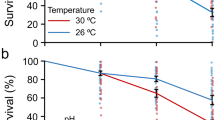Abstract
The effects of food limitation on growth rates and survival of marine invertebrate larvae have been studied for many years. Far less is known about how food limitation during the larval stage influences length of larval life or postmetamorphic performance. This paper documents the effects of food limitation during larval development (1) on how long the larvae ofCrepidula fornicata (L.) can delay metamorphosis in the laboratory after they have become competent to metamorphose and (2) on postmetamorphic growth rate. To assess the magnitude of nutritional stress imposed by different food concentrations, we measured growth rates (as changes in shell length and ash-free dry weight) for larvae reared in either 0.45-μm filtered seawater or at phytoplankton concentrations (Isoehrysis galbana, clone T-ISO) of 1 × l03, 1 × 104, or 1.8 × 105 cells ml−1. Larvae increased both shell length and biomass at 1 × 104 cells ml−1, although significantly more slowly than at the highest food concentration. Larvae did not significantly increase (p > 0.10) mean shell length in filtered seawater or at a phytoplankton concentration of only 1 × 103 cells ml−1, and in fact lost weight under these conditions. To assess the influence of food limitation on the ability of competent individuals to postpone metamorphosis, larvae were first reared to metamorphic competence on a high food concentration ofI. galbana (1.8 × 105 cells ml−1). When at least 80% of subsampled larvae were competent to metamorphose, as assessed by the numbers of indlviduals metamorphosing in response to elevated K+ concentration in seawater, remaining larvae were transferred either to 0.45-μm filtered seawater or to suspensions of reduced phytoplankton concentration (1 × 103, 1 × 104, or 5 × 104 cells ml−1), or were maintained at 1.8 × 105 cells ml−1. All larvae were monitored daily for metamorphosis. Individuals that metamorphosed in each food treatment were transferred to high ration conditions (1.8 × 105 tells ml−1) for four additional days to monitor postmetamorphic growth. Competent larvae responded to all food-limiting conditions by metamorphosing precociously, typically 1 wk or more before larvae metamorphosed when maintained at the highest food ration. Surprisingly, juveniles reared at full ration grew more slowly if they had spent 2 or 3 d under food-limiting conditions as competent larvae. The data show that a rapid decline in phytoplankton concentration during the larval development ofC. fornicata stimulates metamorphosis, foreshortening the larval dispersal period, and may also reduce the ability of postmetamorphic individuals to grow rapidly even when food concentrations increase.
Similar content being viewed by others
References
Allison GW (1994) Effects of temporary starvation on larvae of the sea starAsterina miniata. Mar Biol 118: 255–261
Anger K (1987) The Do threshold: a critical point in the larval development of decapod crustaceans. J exp mar Biol Ecol 108: 15–30
Anger K (1995) Starvation resistance in larvae of a semiterrestrial crab,Sesarma cteracaoense (Decapoda: Grapsidae). J exp mar Biol Ecol 187: 161–174
Baldwin BS, Newell JE (1995) Relative importance of different size food particles in the natural diet of oyster larvae (Crassostrea virginica). Mar Ecol Prog Ser 120: 135–145
Boidron-Métairon IF (1988) Morphological plasticity in laboratory-reared echinoplutei ofDendraster excentricus (Eschscholtz) andLytechinus variegatus (Lamarck) in response to food conditions. J exp mar Biol Ecol 119: 31–41
Carlton JT, Geller JB (1993) Ecological roulette: the global transport of nonindigenous marine organisms. Science 261: 78–82
Chia F-S (1978) Perspectives: settlement and metamorphosis of marine invertebrate larvae. In: Chia F-S, Rice ME (eds) Settlement and metamorphosis of marine invertebrate larvae. Elsevier, New York, pp 283–285
Coon SL, Fitt WK, Bonar DB (1990) Competency and delay of metamorphosis in the Pacific oysterCrassostrea gigas. Mar Biol 106: 379–387
Crisp DJ (1974) Factors influencing the settlement of marine invertebrate larvae. In: Grant PT, Mackie AM (eds) Chemoreception in marine organisms. Academic Press, New York, pp 177–265
Dawirs RR (1983) Respiration, energy balance and development during growth and starvation ofCarcinus maenas L. larvae (Decapoda: Portunidae). J exp mat Biol Ecol 69: 105–128
Dawirs RR (1984) Influence of starvation on larval development ofCarcinus maenas L. (Decapoda: Portunidae). J exp mar Biol Ecol 80: 47–66
Eckert GL (1995) A novel larval feeding strategy of the tropical sand dollar,Encope michelini (Agassiz): adaptation to food limitation and an evolutionary link between planktotrophy and lecithotrophy. J exp mar Biol Ecol 187: 103–128
Fenaux L, Cellario C, Etienne M, Rassoulzadegan F (1988) Sensitivity of different morphological stages of the larva ofParacentrotus lividus (Lamarck) to quantity and quality of food. In: Burke RD, Mladenov PV, Lambert P, Parsley RL (eds) Echinoderm biology. AA Balkema, Rotterdam, The Netherlands, pp 259–266
Fenaux L, Strathmann MF, Strathmann RR (1994) Five tests of food-limited growth of larvae in coastal waters by comparisons of rates of development and form of echinoplutei. Limnol Oceanogr 39: 84–98
Fretter V, Shale D (1973) Seasonal changes in population density and vertical distribution of prosobranch veligers in offshore plankton at Plymouth. J mar biol Ass UK 53: 471–492
Guillard RRL, Ryther JH (1962) Studies of marine planktonic diatoms. I.Cyclotella nana Hustedt andDetonula confervacea (Cleve) Gran. Can J Microbiol 8: 229–239
Hart MW, Strathmann RR (1994) Functional consequences of phenotypic plasticity in echinoid larvae. Biol Bull mar biol Lab, Woods Hole 186: 291–299
Hensley FR (1993) Ontogenetic loss of phenotypic plasticity of age at metamorphosis in tadpoles. Ecology 74: 2405–2412
Highsmith RC, Emlet RB (1986) Delayed metamorphosis: effect on growth and survival of juvenile sand dollars (Echinoidea: Clypeasteroida). Bull mar Sci 39: 347–361
His E, Seaman MNL (1992) Effects of temporary starvation on the survival, and on subsequent feeding and growth of oyster (Crassostrea gigas) larvae. Mar Biol 114: 277–279
Jackson GA, Strathmann RR (1981) Larval mortality from offshore mixing as a link between precompetent and competent periods of development. Am Nat 118: 16–26
Jarrett JN, Pechenik JA (1996) Cyprid quality and juvenile growth capacity vary during the recruitment season for the intertidal barnacleSemibalanus balanoides. Ecology (in press)
Leips J, Travis J (1994) Metamorphic responses to changing food levels in two species of hylid frogs. Ecology 75: 1345–1356
Lima G, Pechenik JA (1985) The influence of temperature on growth rate and length of larval life of the gastropodCrepidula plana Say. J exp mar Biol Ecol 90: 55–71
Lucas JS (1982) Quantitative studies of feeding and nutrition during larval development of the coral reef asteroidAcanthaster planci (L.). J exp mar Biol Ecol 650: 173–193
Mackas DL, Denman KL, Abbott MR (1985) Plankton patchiness: biology in the physical vernacular. Bull mar Sci 37: 652–674
McGee BL, Targett NM (1989) Larval habitat selection inCrepidula (L.) and its effect on adult distribution patterns. J exp mat Biol Ecol 131: 195–214
Miller SE (1993) Larval period and its influence on post-larval life history: comparison of lecithotrophy and facultative planktotrophy in the aeolid nudibranchPhestilla sibogae. Mar Biol 117: 635–645
Morgan SG (1995) Life and death in the plankton: larval mortality and adaptation. In: McEdward L (ed) Ecology of marine invertebrate larvae. CRC Press, New York, pp 279–321
Newman RA (1989) Developmental plasticity ofScaphiopus couchii tadpoles in an unpredictable environment. Ecology 70: 1775–1787
Olson RR (1985) In situ culturing of larvae of the crown-of-thorns starfishAcanthaster planci. Mar Ecol Prog Ser 25: 207–210
Olson RR (1987) The hypothesis of Antarctic larval starvation examined for the asteroidOdontaster validus. Limnol Oceanogr 32: 686–690
Olson RR, Olson MH (1989) Food limitation of planktotrophy marine invertebrate larvae: does it control recruitment success? A Rev Ecol Syst 20: 225–247
Pawlik JR, Mense DJ (1994) Larval transport, food limitation, ontogenetic plasticity, and the recruitment of sabellariid polychaetes. In: Wilson WH Jr, Stricker SA, Shinn GL (eds) Reproduction and development of marine invertebrates. The Johns Hopkins University Press, Baltimore, pp 275–286
Pechenik JA (1979) Role of encapsulation in invertebrate life histories. Am Nat 114: 859–870
Pechenik JA (1980) Growth and energy balance during the larval lives of three prosobranch gastropods. J exp mar Biol Ecol 44: 1–28
Pechenik JA (1984) The relationship between temperature, growth rate, and duration of planktonic life for larvae of the gastropodCrepidula fornicata (L). J exp mar Biol Ecol 74: 241–257
Pechenik JA (1985) Delayed metamorphosis of marine molluscan larvae: current status and directions for future research. Am malac Bull (Spec edn) 1: 85–91
Pechenik JA (1987) Environmental influences on larval survival and development. In: Giese AC, Pearse JS, Pearse VB (eds) Reproduction of marine invertebrates. Vol. X. Blackwell Scientific, Palo Alto, Calif, pp 551–608
Pechenik JA (1990) Delayed metamorphosis by larvae of benthic marine invertebrates: Does it occur? Is there a price to pay? Ophelia 32: 63–94
Pechenik JA, Cerulli TR (1991) Influence of delayed metamorphosis on survival, growth, and reproduction of the marine polychaeteCapitella sp. I. J exp mar Biol Ecol 151: 17–27
Pechenik JA, Eyster LS (1989) Influence of delayed metamorphosis on the growth and metabolism of youngCrepidula fornicata (Gastropoda) juveniles. Biol Bull mar biol Lab, Woods Hole 176: 14–24
Pechenik JA, Gee CC (1993) Onset of metamorphic competence in larvae of the gastropodCrepidula fornicata (L.), judged by a natural and an artificial cue. J exp mar Biol Ecol 167: 59–72
Pechenik JA, Hammer K, Weise C (1996a) The effect of starvation on acquisition of competence and postmetamorphic performance in the marine prosobranch gastropodCrepidula fornicata. J exp mar Biol Ecol 199: 137–152
Pechenik JA, Heyman WD (1987) Using KCl to determine size at competence for larvae of the marine gastropodCrepidula fornicata (L.). J exp mar Biol Ecol 112: 27–38
Pechenik JA, Hilbish TJ, Eyster LS, Marshall D (1996b) Relationship between larval and juvenile growth rates in two marine gastropods,Crepidula plana andC. fornicata. Mar Biol 125:119–127
Pechenik JA, Lima G (1984) Relationship between growth, differentiation, and length of larval life for individually reared larvae of the marine gastropod,Crepidula fornicata. Biol Bull mar biol Lab, Woods Hole 166: 537–549
Pechenik JA, Rittschof D, Schmidt AR (1993) Influence of delayed metamorphosis on survival and growth of juvenile barnaclesBalanus amphitrite. Mar Biol 115: 287–294
Perron FE, Turner RD (1977) Development; metamorphosis, and natural history of the nudibranchDoridella obscura Verrill (Corambidae: Opisthobranchia). J exp mar Biol Ecol 27: 171–185
Qian P-Y, Chia F-S (1991) Effects of food concentration on larval growth and development of two polychaete wormsCapitella capitata (Fabricius) andPolydora ligni Webster. Bull mar Sci 48: 477–484
Qian P-Y, Chia F-S (1993) Larval development as influenced by food limitation in two polychaetes:Capitella sp. andPolydora ligni Webster. J exp mar Biol Ecol 166: 93–105
Qian P-Y, McEdward LR, Chia F-S (1990) Effects of delayed settlement on survival, growth, and reproduction in the spionid polychaete,Polydora ligni. Invert Reprod Dev 18: 147–152
Richter G (1973) Field and laboratory observations on the diurnal vertical migration of marine gastropod larvae. Neth J Sea Res 7: 126–134
Rumrill SS (1990) Natural mortality of marine invertebrate larvae. Ophelia 32: 163–198
Scheltema RS (1986) On dispersal and planktonic larvae of benthic invertebrates: an eclectic overview and summary of problems. Bull mar Sci 39: 290–322
Seliger HH, McKinley KR, Biggley WH, Rivkin RB, Aspden KRH (1981) Phytoplankton patchiness and frontal regions. Mar Biol 61: 119–131
Semlitasch RD, Scott DE, Pechmann JHK (1988) Time and size at metamorphosis related to adult fitness inAmbystoma talpoideum. Ecology 69: 184–192
Strathmann RR, Fenaux L, Sewell AT, Strathmann MF (1993) Abundance of food affects relative size of larval and postlarval structures of a molluscan veliger. Biol Bull mar biol Lab, Woods Hole 185: 232–239
Thorson G (1950) Reproductive and larval ecology of marine bottom invertebrates. Biol Rev 25: 1–45
Vance RR (1973) On reproductive strategies in marine benthic invertebrates. Am Nat 107: 339–361
Villafane VE, Helbling EW, Holm-Hansen O (1995) Spatial and temporal variability of phytoplankton biomass and taxonomie composition around Elephant Island, Antarctica, during the summers of 1990–1993. Mar Biol 123: 677–686
Walne PR (1965) Observations on the influence of food supply and temperature on the feeding and growth of the larvae ofOstrea edulis L. Fishery Invest Lond 24: 1–43
Wehrtmann IS (1991) How important are starvation periods in early larval development for survival ofCrangon septenispinosa larvae? Mar Ecol Prog Ser 73: 183–190
Wendt DE (1996) Effect of larval swimming duration on success of metamorphosis and size of the ancestrular Iophophore inBugula neritina (Bryozoa). Biol Bull mar biol Lab, Woods Hole 191: (in press)
Wilbur HM, Collins JP (1973) Ecological aspects of amphibian metamorphosis. Science 182: 1305–1314
Woollacott RM, Pechenik JA, Imbalzano KM (1989) Effects of duration of larval swimming period on early colony development inBugula stolonifera (Bryozoa: Cheilostomata). Mar Biol 102: 57–63
Young CM, Chia F-S (1987) Abundance and distribution of pelagic larvae as influenced by predation, behavior, and hydrographie factors. In: Giese AC, Pearse JS, Pearse VB (eds) Reproduction of marine invertebrates. Vol. IX. Blackwell Scientific, Palo Alto, Calif., pp 385–463
Zimmermann, Pechenik JA (1991) How do temperature and salinity affect relative rates of growth, morphological differentiation, and time to metamorphic competence in larvae of the marine gastropodCrepidula plana? Biol Bull mar biol Lab, Woods Hole 180: 372–386
Author information
Authors and Affiliations
Additional information
Communicated by J.P. Grassle, New Brunswick
Rights and permissions
About this article
Cite this article
Pechenik, J.A., Estrella, M.S. & Hammer, K. Food limitation stimulates metamorphosis of competent larvae and alters postmetamorphic growth rate in the marine prosobranch gastropodCrepidula fornicata . Mar. Biol. 127, 267–275 (1996). https://doi.org/10.1007/BF00942112
Received:
Accepted:
Issue Date:
DOI: https://doi.org/10.1007/BF00942112




